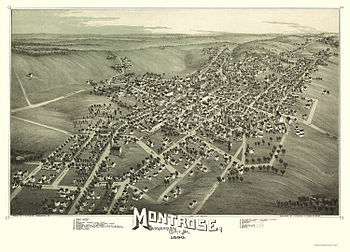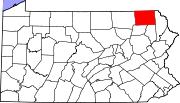- Montrose, Pennsylvania
-
Montrose, Pennsylvania — Borough — Downtown Montrose, Pennsylvania Nickname(s): Quarry Town Coordinates: 41°49′59″N 75°52′38″W / 41.83306°N 75.87722°WCoordinates: 41°49′59″N 75°52′38″W / 41.83306°N 75.87722°W Country United States State Pennsylvania County Susquehanna Settled 1812 Incorporated 1859 Area – Total 1.3 sq mi (3.3 km2) Elevation 1,400 ft (627 m) Population (2007) – Total 1,843 – Density 1,288.2/sq mi (498.0/km2) Time zone Eastern (EST) (UTC-5) – Summer (DST) EDT (UTC-4) Zip code 18801 Area code(s) 570 Montrose is a borough in Susquehanna County, Pennsylvania, United States, 46 miles (74 km) north by west of Scranton, Pennsylvania. Montrose was laid out in 1812 and incorporated as a borough on March 19, 1824. Its name is a combination of "mont", the French word for “mountain” and Rose, for Dr. L R. Rose, a prominent citizen. The land is elevated about 1,400 feet (427 m) above sea level. The traditional older industries included creameries and the manufacturing of cut glass, boxes, sawing machinery, lumber, etc. In 1900, 1,827 people lived here, and in 1910, 1,914 people lived here. The population was 1,664 at the 2000 census. A 2007 estimate states that the population is 1,843. It is the county seat of Susquehanna County[1]. The area of Montrose is notable for its many quarry sites. A type of rock that is indigenous to this area is called blue stone. The Montrose Club a private golf course is said to be one of the oldest golf courses in the United States.
Contents
History
Montrose incorporated itself as a town and seat of Susquehanna County in 1824, but families began immigrating to the area in the mid Eighteenth Century, primarily from areas along the Connecticut River Valley (western Connecticut, Massachusetts, and Vermont). The American Revolution dramatically changed the political and built environments of New England, and consequentially, many inhabitants desired vast and affordable land in the western lands of Pennsylvania. When settlers arrived in what we be known as Susquehanna County they found rolling hills, clear lakes, and mountain streams with an abundance of natural resources like timber and bluestone. In a very short period of time, the first families built Montrose like familiar New England towns – large colonial style houses surrounding churches with a main street straddling the town. A town “green” adjacent to the courthouse allowed for community events, a spirit that still carries on to the present day.
Arguably, the most mystified (and thus contested) aspect of the town’s history occurred during the height of America’s Civil War. Several townsfolk and local historians claim that Montrose played a significant role in the Northern Trail of the Underground Railroad, housing several slave families in the area. Folklore has it that many of these families remained in Montrose and across the county after the War. These supposed connections opened a floodgate of local residents seeking historical landmark status for their homes in the twentieth and twenty-first centuries, many of which were denied by the Pennsylvania Historical Commission due to lack of evidence that the events actually took place. Several academic historians believe that, while the possibility of a family or two stopping in Montrose along the Northern Trail is certainly plausible, the number of increased African Americans during the time is most likely explained by the then-bourgeoning coal industry just south of the county that appealed to many immigrants and former slaves looking for work. The Susquehanna County Historical Society and the Center for Anti-Slavery Studies (housed in one of the suspected homes) remains dedicated to identifying and analyzing primary documents of the time, but little legitimate data exists to satisfy the burdens of the Underground Railroad claims.
Geography
Montrose is located at 41°49′59″N 75°52′38″W / 41.83306°N 75.87722°W (41.833064, -75.877190)[2].
According to the United States Census Bureau, the borough has a total area of 1.3 square miles (3.4 km2), 99.9% of it land.
Demographics
As of the census[3] of 2000, there were 1,664 people, 734 households, and 405 families residing in the borough. The population density was 1,288.2 people per square mile (498.0/km²). There were 834 housing units at an average density of 645.7 per square mile (249.6/km²). The racial makeup of the borough was 98.86% White, 0.48% African American, 0.06% Asian, 0.06% from other races, and 0.54% from two or more races. Hispanic or Latino of any race were 0.30% of the population.
There were 734 households out of which 24.1% had children under the age of 18 living with them, 42.4% were married couples living together, 9.8% had a female householder with no husband present, and 44.7% were non-families. 40.2% of all households were made up of individuals and 24.1% had someone living alone who was 65 years of age or older. The average household size was 2.18 and the average family size was 2.96.
In the borough the population was spread out with 23.3% under the age of 18, 8.8% from 18 to 24, 25.8% from 25 to 44, 20.3% from 45 to 64, and 21.7% who were 65 years of age or older. The median age was 39 years. For every 100 females there were 86.3 males. For every 100 females age 18 and over, there were 79.5 males.
The median income for a household in the borough was $30,200, and the median income for a family was $46,607. Males had a median income of $30,845 versus $22,107 for females. The per capita income for the borough was $19,662. About 7.7% of families and 14.8% of the population were below the poverty line, including 11.1% of those under age 18 and 11.8% of those age 65 or over.
Notable people
- Chris Snee, offensive guard for the New York Giants
- Rich Thompson, outfielder for the Lehigh Valley IronPigs
- Charles Martin Crandall toy-maker
See also
- Woodbourne Forest and Wildlife Preserve
References
- ^ "Find a County". National Association of Counties. http://www.naco.org/Counties/Pages/FindACounty.aspx. Retrieved 2011-06-07.
- ^ "US Gazetteer files: 2010, 2000, and 1990". United States Census Bureau. 2011-02-12. http://www.census.gov/geo/www/gazetteer/gazette.html. Retrieved 2011-04-23.
- ^ "American FactFinder". United States Census Bureau. http://factfinder.census.gov. Retrieved 2008-01-31.
External links
Municipalities and communities of Susquehanna County, Pennsylvania Boroughs Forest City | Friendsville | Great Bend | Hallstead | Hop Bottom | Lanesboro | Little Meadows | Montrose | New Milford | Oakland | Susquehanna Depot | Thompson | Union Dale
Townships Unincorporated
communityCounty seats of Pennsylvania Cities Allentown | Butler | Easton | Erie | Franklin | Greensburg | Harrisburg | Lancaster | Lebanon | Lock Haven | Meadville | New Castle | Philadelphia | Pittsburgh | Pottsville | Reading | Scranton | Sunbury | Uniontown | Warren | Washington | Wilkes-Barre | Williamsport | York
Boroughs Beaver | Bedford | Bellefonte | Bloomfield | Brookville | Carlisle | Chambersburg | Clarion | Clearfield | Coudersport | Danville | Doylestown | Ebensburg | Emporium | Gettysburg | Hollidaysburg | Honesdale | Huntingdon | Indiana | Jim Thorpe | Kittanning | Laporte | Lewisburg | Lewistown | McConnellsburg | Media | Mercer | Middleburg | Mifflintown | Milford | Montrose | Norristown | Ridgway | Smethport | Somerset | Stroudsburg | Tionesta | Towanda | Tunkhannock | Waynesburg | Wellsboro | West Chester
Town Categories:- Boroughs in Susquehanna County, Pennsylvania
- County seats in Pennsylvania
- Populated places established in 1812
Wikimedia Foundation. 2010.




